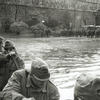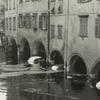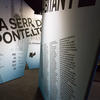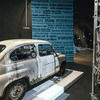November 1966. History of the defence of the land in Trentino
An exhibition on the defence of the land in Trentino after the dramatic days of the flood of 1966; on one hand it was of course a natural disaster, on the other hand it fostered solidarity and an adequate critical reconsideration of land use.

The flood of November 1966 and the history of the defence of the land in Trentino. A complex topic that deserves this large and committing exhibition along the three hundred metres
of the black tunnel.
Three are the reasons that have driven the Trentino History Museum Foundation to create this exhibition with the support and sponsorship of the Autonomous Province of Trento.
The first reason regards the evocative power of the anniversary. Fifty years have gone by since that month of November in 1966 in which the flood devastated our land. An event that many men and women remember and that has cut deeply into the memories of the individual communities, from the districts of Trento to the hardest hit areas and valleys. It is also an event that has had an impact on this land over time. Beyond their dramatic nature, the
deaths, the material damage, those days in November have had significant consequences that have deeply changed our land, its society and its economy as well as the way in which we have come to perceive policies and public action.
The second reason regards the importance of the history of the defence of the land in Trentino. The year 1966 is only a moment in a much longer story made up of centuries that have seen a long succession of governments and administrations, and in which the land was subjected to strategies, projects and actions that are not visible to the ‘naked eye’ and therefore that we fail to read and interpret. The solution is to provide space for the ‘material’ and physical dimension of the story.
The third reason regards our autonomy and the model that Trentino has built in terms of land management, prevention and protection. Our intent is that this grand exhibition succeed in making visible and representable this heritage that has been cherished and implemented by different generations, so rich in visions, accomplishments and experience.
The exhibition consists of six sections:
Section 1. The events
The "immersive tunnel” offers a selection of films, narrating some of the worst flood events in Italy and in the world in the past twenty years.
Section 2. 18.000 weirs
Hydraulic engineering works in Trentino
The complex issues related to the control and management of the water network in Trentino in the course of the centuries has led to the construction of an enormous network of hydraulic
engineering works put in place to defend the land, protecting it and preventing the damage caused by floods. Including the small, medium-sized and large structures, today Trentino has almost 18,000 weirs and about 900,000 kilometres of embankments and trenches. These structures are distributed in a dense pattern on all of the province’s drainage basins along the major watercourses and their tributaries.
Section 3. Go up the river and relive its history
A 50 metre long table takes visitors on a journey until the dawn of the year 1966. It tells the story of the defence of Trentino from a geographical as well as chronological point of view.
Section 4. The flood of 1966
It is the largest section, which takes up about a third of the exhibition, over 100 metres of extension.
In November 1966, the intense rainfalls that hit Trentino were just a part of a much larger weather perturbation that involved the whole of the Italian peninsula. A large number of regions, provinces and cities were damaged. This was the year in which the dramatic flood of Florence occurred, and other northern cities were affected as well: Venice, Udine, Brescia, Grosseto and Padua. The perturbation, however, was more concentrated in the North-east. The exceptional rainfalls caused by the permanence above the country of cyclonic cells created by two currents of air, a hot southern one and a cold northern one, generated lengthy and exceptionally heavy rainfalls.
Section 5. The aftermath of 1966
From 1966 to the present.
The year 1966 has been a turning point in the history of the defence of the land in Trentino. The flood triggered change at institutional, organizational, town-planning and management
level. By means of the creation of autonomous government tools, the provincial institutions have guaranteed constant financing for the protection from and the prevention of the risk of damage caused by geological and hydrogeological events.
Section 6. The keywords of Autonomy
Autonomy. Protection. Prevention. Preparation. Community. Responsibility. Participation.
This exhibition is also an opportunity to raise funds for rebuilding places of important historical value which were destroyed by the earthquake in central Italy last summer.
Source: www.museostorico.it
Free admission
organization: Fondazione museo storico del Trentino (Trentino history museum foundation)







